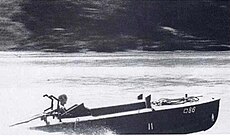Shin'yō-class_suicide_motorboat
Shinyo (suicide motorboat)
Motorboats used for suicide attacks by the Imperial Japanese Navy
The Shinyo (震洋, Shin'yō, "Sea Quake") were Japanese suicide motorboats developed during World War II. They were part of the wider Japanese Special Attack Units program.
This article needs additional citations for verification. (October 2009) |
 A Shinyo suicide motorboat being tested by Lt Col James F. Doyle USA commanding officer 2nd Battalion, 305th Infantry 69th Division | |
| Class overview | |
|---|---|
| Name | Shin'yō-class suicide motorboat |
| Builders | Yokosuka Naval Arsenal |
| Operators | |
| Subclasses | Shinyo Type 1, Shinyo Type 5 |
| Built | April 1944–June 1945 |
| In commission | August 1944–August 1945 |
| Planned | 11,300 |
| Completed | 6,197 |
| Lost | At least 36 |
| General characteristics | |
| Class and type | Motorboat |
| Displacement |
|
| Speed | |
| Crew | Type 1: 1, Type 5: 2 |
| Armament | |

Towards the end of 1943, in response to unfavorable progress in the war, the Japanese high command heard suggestions for various suicide craft. These suggestions were initially rejected as "defeatist" but later deemed necessary.[1] For the naval department this meant kamikaze planes, kaiten submarines, fukuryu suicide divers or human naval mines, and shinyo suicide boats.
These fast motorboats were driven by one man, to speeds of around 55 km/h (30 kn). They were typically equipped with a bow-mounted charge of up to 300 kg (660 lb) of explosives that could be detonated by either impact or from a manual switch in the driver's area. These attack boats also carried two anti-ship rockets mounted on launchers located on either side of the boat behind the driver.
The similar Maru-Ni, which were used by the Imperial Japanese Army, were equipped with two depth charges, and were not actually suicide boats, as the idea was to drop the depth charges and then turn around before the explosion took place. Although the chances of the boat and crew surviving the wave from the explosion might seem slim, a small number of crewmen successfully escaped.[2] The depth charges used were known as the Experimental Manufacture Use 120 kg Depth Charge, and were armed by a delayed-action pull igniter.
The program began in March 1944. The first vessels were tested on 27 May, after which it was decided that the original steel hull design would be replaced by a wooden hull due to the Japanese steel shortage. On 1 August, 150 students, on average 17 years old, elected to begin training for the Shinyo.[3]
6,197 Shinyo boats were produced for the Imperial Japanese Navy and 3,000 Maru-ni for the Imperial Japanese Army.[4] Around 400 boats were transported to Okinawa and Formosa, and the rest were stored on the coast of Japan for the ultimate defense against the expected invasion of the Home islands. The main operative use took place during the Philippines Campaign of 1944–45.
- January 10, 1945: Sinking of American ships USS LCI(G)-365 (Landing Craft Infantry – Gunboat), USS LCI(M)-974 (Landing Craft Infantry – Mortar) and crippling of USS War Hawk (an auxiliary transport) in Lingayen Gulf, Luzon, Philippines.
- January 31, 1945: Sinking of USS PC-1129 (Submarine chaser) off Nasugbu in Luzon, Philippines.
- February 16, 1945: Sinking of USS LCS(L)-7 (Landing Craft Support – Large), LCS(L)-26, and LCS(L)-49 off Mariveles, Corregidor Channel, Luzon.
- April 4, 1945: Sinking of USS LCI(G)-82 (Landing Craft Infantry – Gunboat) and USS LSM-12 (Landing Ship Medium) off Okinawa.
- April 9, 1945: Damaging of USS Charles J. Badger (DD-657).
- April 27, 1945: Crippling of USS Hutchins (DD-476) in Buckner Bay, Okinawa.
- May 4, 1945: Damaging of USS Carina (AK-74) in the north end of Buckner Bay, Okinawa.
- Japanese suicide craft. US Navy. 1946.
- Morison, Samuel Eliot (1959). History of United States Naval Operations in World War II: The Liberation of the Philippines. University of Illinois Press. pp. 138–140. ISBN 0-252-07064-X.
- Hackett, Robert; Kingsepp, Sander (26 November 2011). "Battle Histories of Japan's Explosive Motorboats". www.combinedfleet.com. Retrieved 2019-03-13.